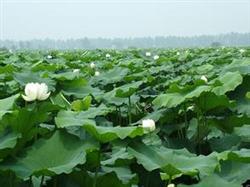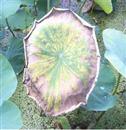Prevention is the key to the rot of lotus root.

Rot disease is a common disease on lotus root, which occurs to varying degrees every year. The planting area of lotus root in Wuhan is large, and the local lotus root rot occurs seriously. Lotus root species in most areas are introduced from Wuhan, so the disease of lotus root field rot has occurred seriously in some areas in recent years. After the disease, the vascular bundles of the plant will turn brown and rot, so there will be strip rot on the lotus root segment. In the field of continuous cropping for many years, the pathogen accumulated in the field and the disease was serious. The disease mainly harms the underground part of lotus root, and it is difficult to reach the disease department directly after drug application, so it is difficult to prevent and cure. Rotation and selective lotus root seeds before sowing are the most effective measures to prevent and cure the disease. After the disease, the diseased plant should be removed and the hole should be sealed with quicklime to prevent the bacteria from spreading outward. Spraying carbendazim, thiophanate methyl and other drugs has no good therapeutic effect on the diseased plants, but can protect the healthy plants. It is understood that the rot disease mainly harms the underground stem of lotus root, showing brown rot, and the disease leads to aboveground withering. At the beginning of the disease, the color of the leaf became pale, the leaf edge dried up and turned brown, and curled down. finally, the whole leaf dried up and turned brown, and the petiole atrophied and died from top to bottom, and gradually spread to the new leaf after the old leaf lesion. When the underground stem was damaged, the initial symptoms were not obvious, the vascular bundles inside the dissected stem first became light brown to brown, then brown or purple-black disease spots appeared on the outside, and finally the whole stem rotted, causing the aboveground to die, and in serious cases, the whole field was withered and yellow. The disease is caused by a variety of bacteria. The pathogen overwinters in the lotus root and lotus root soil, and can also enter the lotus root field through irrigation water and spread to the surrounding lotus root field. The disease began in early June and flourished from mid-July to early August. The bacteria infected rapidly under the conditions of 23-30 ℃ and continuous overcast, lack of sunshine or frequent storms. The acidity of lotus root field is high, the water temperature is higher than 35 ℃, the harm of root-eating golden flower insect is serious, or the application of immature organic fertilizer or partial application of nitrogen fertilizer is serious. To prevent and cure lotus root rot, one is to select strong and disease-free lotus root, spray with 70% methyl thiophanate wettable powder or 75% chlorothalonil wettable powder or 50% carbendazim wettable powder 800 times, cover film and seal for 24 hours, dry and plant. The second is reasonable rotation, which is best in the form of lotus root, rice, winter soaking rotation or lotus root and alisma rotation. The third is to turn the lotus root field deeply before planting, properly air, sprinkle 200-250 kg of quicklime per mu. Fourth, strengthen fertilizer and water management, apply fully rotten organic fertilizer, nitrogen, phosphorus and potassium fertilizer, timely and appropriate amount of fertilizer during the growing period, not partial application of nitrogen fertilizer; scientific management of water, moderate depth, regulating temperature and fertilizer with water to prevent aggravation of the disease due to high water temperature or long-term deep irrigation. Fifth, chemical control, spray with 50% carbendazim wettable powder 600 times or 70% thiophanate methyl wettable powder 700 times. At the same time, use 50% carbendazim wettable powder plus 75% chlorothalonil wettable powder 500 grams mixed with fine soil 30 kg per mu, pile up for 3-4 hours before spreading, and maintain the shallow water layer in the field. The two methods can be carried out at the same time, every 7 days, continuous prevention and treatment for 2-3 times.
- Prev

There are ways to apply fertilizer for high yield of lotus root.
First, fine soil preparation, the application of sufficient fertilizer lotus root grows in the soil, it requires that the soil is rich in humus, soft and loose, and good air permeability, which is most conducive to the growth of lotus root, and easy to obtain high quality and high yield. Therefore, the soil should be deeply turned over before planting lotus root, fine soil preparation and adequate basic fertilizer should be applied. It is usually thawed at the end of winter.
- Next

Prevention and control of lotus root rot should be timely.
Q: the lotus root planted in my family grew very well at the beginning, but now the leaves have dried up and several drugs have not worked. What on earth is going on? What kind of medicine can be cured? At present, lotus root leaf disease is mainly lotus root rot disease, which is the first major disease in lotus root production.
Related
- Where is it suitable to grow horseradish in China? it is expected to see the middle altitude horseradish in Alishan.
- How to prevent tomato virus disease reasonably? (Control methods included)
- Many people like to plant towel gourd on the balcony. What are the main points of this method and management?
- What crops can chili peppers be mixed with?
- Fertilization techniques and matters needing attention in Tomato
- What are the grafting techniques for peach seedlings in spring?
- Harm and control methods of root swelling disease of Chinese cabbage
- What are the pests of sweet potatoes? How to prevent and cure it?
- Symptoms, causes and Control methods of navel Rot in Tomato
- The cause of "Cucumber rotten bibcock" in Farmers' planting Cucumber and its Control Plan

